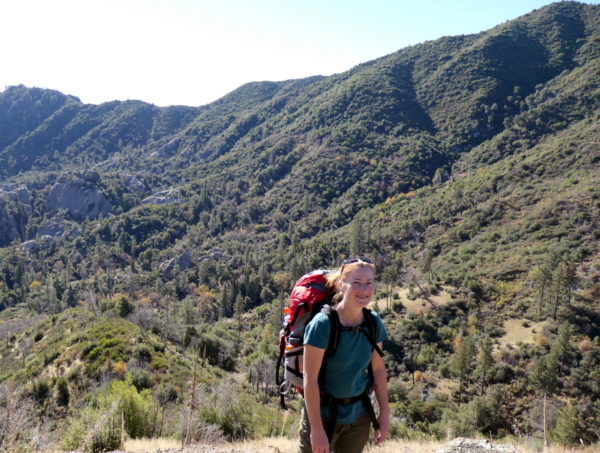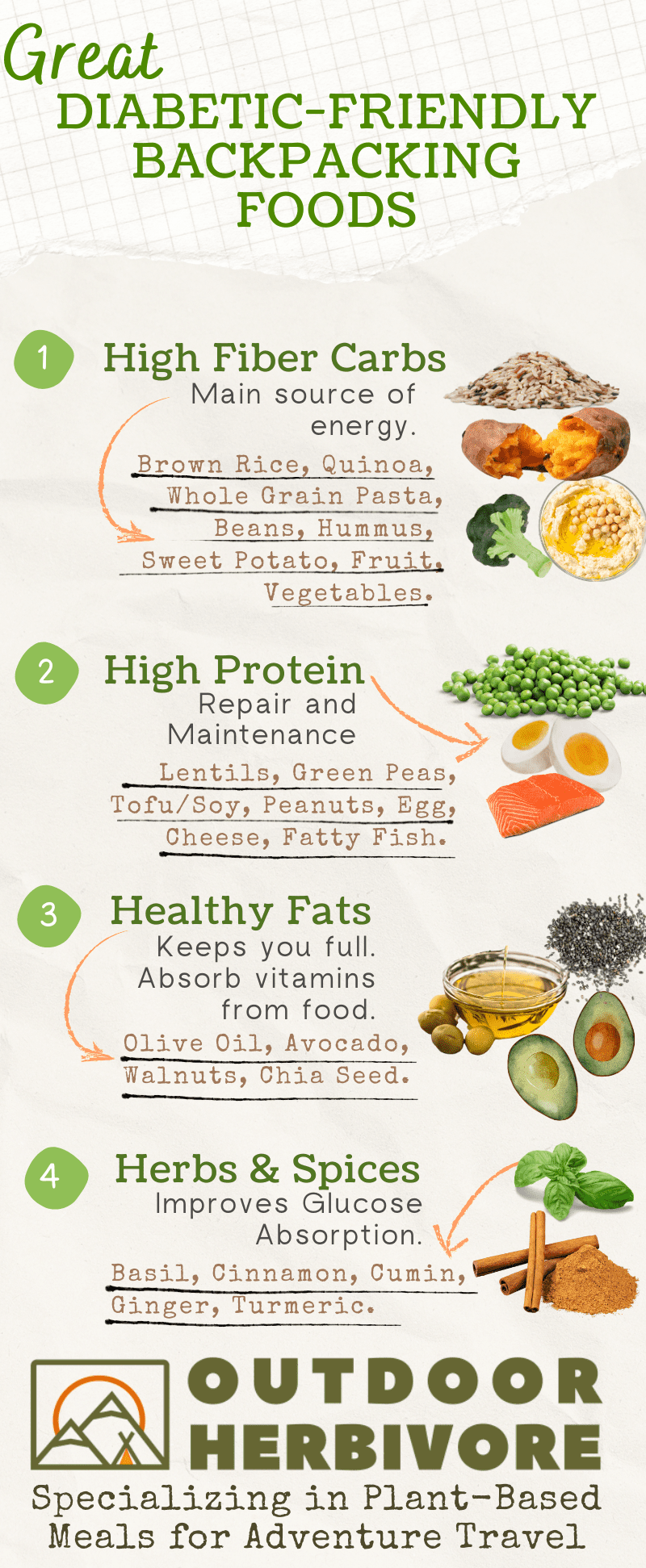
Consuming a surplus of calories long-term leads to the accumulation of fat in the liver and pancreas that causes type 2 diabetes (T2D). Any activity that decreases intra-organ fat can put diabetes into remission. Backpacking is an excellent activity for people with diabetes. It’s a moderately intense aerobic activity that reduces weight and builds muscle mass, improving insulin sensitivity and lowering blood glucose. In fact, for every 10% increase in muscle mass, you get an 11% reduction in insulin resistance.[1]
With some planning, you can find trail food to keep blood sugar levels in check. Here are some suggested diabetic-friendly backpacking foods.
Diabetic-Friendly Backpacking Foods

People with diabetics should look for the following criteria in backpacking food:
1. High-Fiber Carbohydrates
Meals that are high in carbohydrates require care for diabetics. When you eat food loaded with carbohydrates, the digestive system breaks down the digestible ones into sugar, which enters the blood and triggers the pancreas to release insulin. In diabetics, the pancreas can’t produce insulin, and blood glucose levels can rise to very high levels. Without insulin, the body cannot access enough sugar to function properly, and the liver turns some of the body fat into acids called ketones. When excess ketones enter the blood, the blood becomes acidic, causing Diabetic ketoacidosis (DKA), a serious complication involving very high blood sugar, dehydration, shock, and exhaustion.
While carbohydrate metabolism is vital in managing diabetes, eating low-carb trail food is not recommended. Endurance activities, such as hiking, require prolonged muscle use and energy from carbohydrates. Carbohydrates are the most efficient source of muscle energy — consuming up to 90% of energy transported in the blood. The key is to look for carbohydrate-rich foods containing high amounts of fiber.
Foods containing whole grains and vegetables contain higher fiber than meals with simple carbohydrates or refined grains, and added sugars. For instance, brown rice, buckwheat soba noodles, barley, whole wheat pasta/breads, oats, quinoa, and amaranth are whole grains, whereas white rice and instant noodles are simple carbohydrates. Fiber intake is important because fiber slows down digestion (glucose release) and stabilizes blood sugar levels. A slow and steady glucose release is ideal for maintaining consistent energy for extended endurance activities such as hiking, backpacking, and bikepacking. Another benefit of high-fiber meals is that they make you feel full, which means you will desire to eat fewer calories. [2]
Low Added Sugar is also important. Instead of straight sugar for sweetness, look for natural sweeteners from dried fruits and vegetables, such as berries, bananas, dates, figs, and sweet potatoes. Sugar coming from a small amount of dried fruits will avoid excessive sugar. Although dried fruits like bananas, raisins, and dates are good sources of fiber and carbohydrates, they have a high glycemic index (GI) and should be eaten in moderation to avoid blood sugar spikes. Instant sweet potatoes are an excellent replacement for white potatoes. Trail mix and snack bars containing nuts, seeds, and dried fruit offer a healthy balance of protein, fiber, and essential fatty acids. Nuts and seeds provide long-lasting energy and are packed with vitamins and minerals. Dried fruits contain sugar with fiber, providing a healthy carbohydrate option for sustained energy.
2. High Protein
Opt for plant-based protein sources from beans, lentils, nuts, seeds, and whole grains, which help keep the heart healthy and offer essential amino acids for muscle repair. Texurized Pea Protein made from yellow peas is an excellent choice for boosting the protein content of backpacking meals because it rehydrates within a minute in hot water. Otherwise, non-plant based proteins such as fish high in omega-3 fatty acids, such as sardines, salmon, and tuna, can help improve heart health. Pouched fish packed in olive oil can be an excellent high-calorie source of protein and fat when backpacking or traveling.
3. Healthy Fats
Fats don’t directly affect blood sugar but are necessary to absorb nutrients from food, slow the absorption of carbohydrates, and provide flavor. Be careful not to consume too many of the wrong fat types, such as saturated fats. If a food contains added fat or oil, look for healthier mono-unsaturated fats, such as olive oil, avocado oil, and seed oils. Unsaturated plant-based fats can improve blood sugar control and blood lipids in people with diabetes.[3]
4. Beneficial Spices & Herbs
Herbs and spices offer seasonings and flavorings to food. Some of these plants contain metabolites such as flavonoids, terpenoids, alkaloids, and polysaccharides that have a medicinal anti-diabetic effect on the body. For instance, common spices such as allspice, basil, cinnamon, clove, fenugreek, ginger, lemongrass, nutmeg, oregano, rosemary, and turmeric (curcumin) offer substances that help regulate glucose metabolism and insulin secretion. Cinnamon is commonly used to impart a sweet flavor to meals without adding sugar. [4]
5. Reasonable Sodium
Because many people with diabetes tend to have higher blood pressure, it is important to moderate sodium levels. With that said, backpacking does burn sweat, so it’s generally OK to go beyond your regular intake while on the trail.
Other Tips
- Choose healthier snacks containing nuts and seeds, which are both a fat and protein. Raw, sturdy vegetables like carrots, celery, and bell peppers can be cut up and packed in a zip-top bag for a healthy snack when paired with hummus or nut butter. These foods offer a healthy combination of protein, healthy fats, and fiber, contributing to stable blood sugar levels and sustained energy.
- Stay hydrated with water! Drinking enough water regulates blood sugar levels and prevents dehydration. Opt for non-sugared mixes such as True lemon/lime/orange packets if you want flavor.
- Go vegetarian. A vegetarian diet — one that excludes animal products laden with saturated fats – and emphasizes eating whole grains, fruits, vegetables, legumes, nuts, and seeds can improve blood sugar control and make your body more responsive to insulin. [5]
Balancing proper nutrition and managing blood sugar can be challenging when choosing diabetic-friendly backpacking food. However, with proper planning, you can enjoy delicious trail foods that provide the fuel you need. Most of Outdoor Herbivore’s meals are an excellent fit for diabetics because they are made using plant-based foods high in dietary fiber and nutrients, including whole grains, legumes, vegetables, fruits, seeds, and nuts. A plant-based vegetarian diet that concentrates on foods such as these gives people with diabetes optimal blood glucose control.
Outdoor Herbivore’s Meal Recommendations for T2D (all values listed are per Single Size Serving)
| Product Name | Meal Type | Added Sugar | Total Cal (kcal) | Total Fat (g) | Sat Fat (g) | Chol (mg) | Sodium (mg) | Carbs (g) | Fiber (g) | Sugar (g) | Protein (g) |
| Savory Lentil Simmer | Soup | N | 460 | 10 | 5 | 0 | 610 | 75 | 20 | 15 | 23 |
| Blackened Quinoa | Entrée | N | 570 | 19 | 2 | 0 | 550 | 80 | 19 | 8 | 20 |
| Switchback Soup & Stuffer | Entrée | N | 400 | 10 | 3 | 13 | 500 | 68 | 19 | 13 | 22 |
| Cheddar Mac | Entrée | N | 530 | 4 | 0 | 0 | 600 | 94 | 18 | 13 | 29 |
| Chunky Chipotle Chili | Soup | N | 370 | 4 | 0 | 0 | 720 | 70 | 17 | 18 | 18 |
| Happy Fella Pestobella | Entrée | N | 650 | 26 | 3 | 0 | 600 | 80 | 17 | 10 | 25 |
| Naked Freckle Burrito | Entrée | N | 430 | 5 | 0 | 0 | 470 | 85 | 17 | 5 | 16 |
| Basil Walnut Penne | Entrée | N | 650 | 29 | 2 | 0 | 560 | 74 | 16 | 5 | 24 |
| Cozy Curry Soup | Soup | N | 450 | 9 | 0 | 0 | 600 | 73 | 14 | 8 | 22 |
| Lickety-Split Lentils | Entrée | N | 570 | 15 | 2 | 0 | 600 | 90 | 14 | 13 | 23 |
| Pea-Nutty Matchsticks | Entrée | N | 620 | 21 | 6 | 0 | 570 | 83 | 14 | 10 | 29 |
| Chia Oat Crunch | Breakfast | N | 420 | 19 | 2 | 0 | 3 | 50 | 12 | 9 | 14 |
| Chickpea Sesame Zetti | Entrée | N | 650 | 26 | 2 | 0 | 570 | 87 | 12 | 6 | 22 |
| Fiesta Quinoa Salad | Entrée | N | 430 | 13 | 2 | 0 | 130 | 71 | 12 | 7 | 9 |
| Lemongrass Thai Curry | Entrée | N | 630 | 34 | 20 | 0 | 570 | 71 | 12 | 7 | 15 |
| Packit Primavera | Entrée | N | 550 | 18 | 10 | 49 | 530 | 68 | 12 | 9 | 27 |
| Lemony Herb Salad | Entrée | N | 430 | 16 | 2 | 0 | 600 | 68 | 8 | 14 | 8 |
| Sunrise Tofu Scramble | Breakfast | N | 260 | 9 | 1 | 0 | 600 | 25 | 6 | 10 | 24 |
In a nutshell, diabetics should look for trail foods made with high-fiber carbohydrates, plant-based protein, unsaturated fats, and beneficial herbs/spices, which can help slow digestion and prevent spikes in glucose levels after eating.
References
[1] Relative Muscle Mass Is Inversely Associated with Insulin Resistance and Prediabetes
[2] Effects of soluble fiber supplementation on glycemic control in adults with type 2 diabetes
[3] Healthy Fats
[4] Evaluation of the Anti-Diabetic Activity of Some Common Herbs and Spices
[5] Impact of vegetarian diet for diabetes